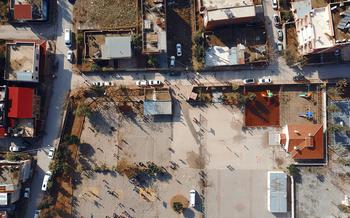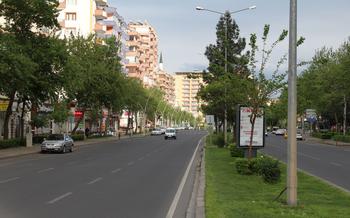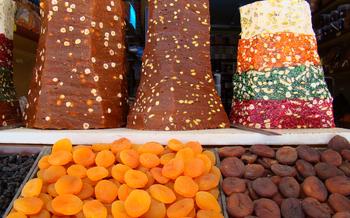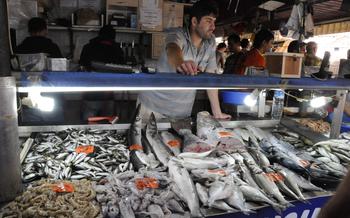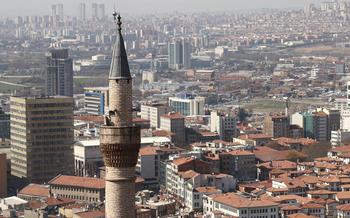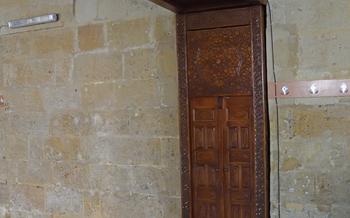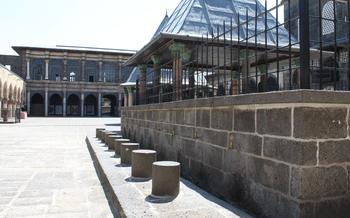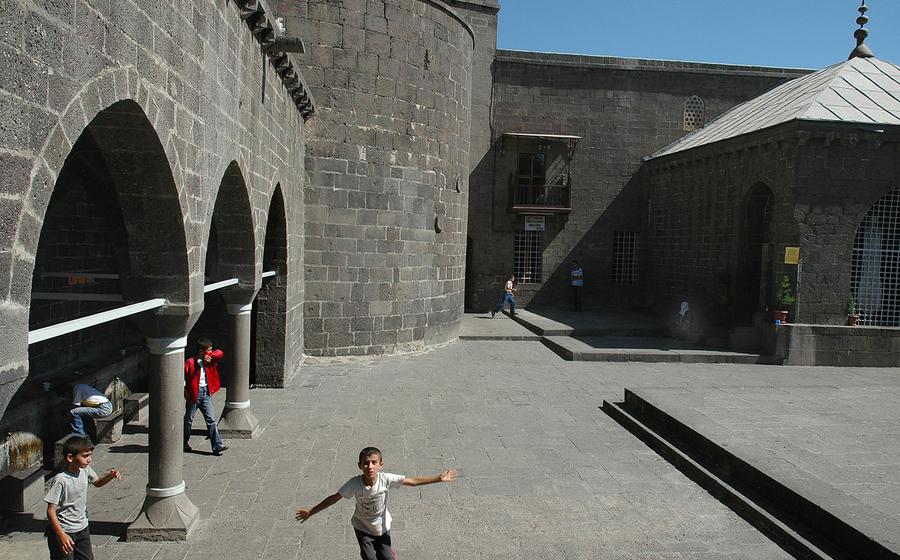
Kale Mosque
- Architectural Marvel
- Prayer Hall and Mihrab
- Calligraphy and Inscriptions
- Prayer Times and Etiquette
- Local Traditions and Customs
- Guides and Tours
- Photography and Videography
- Nearby Attractions:
- Souvenirs and Local Crafts:
- Food and Dining
- Accommodation and Hotels
- Transportation and Accessibility
Architectural Marvel
The Kale Mosque stands as a testament to the architectural prowess of the Artuqid dynasty. Its unique blend of Islamic and Byzantine styles creates a harmonious ensemble that is both visually stunning and historically significant. The mosque's exterior boasts intricate carvings, inscriptions, and mosaics that tell stories of its rich past. The main entrance is adorned with a magnificent arch, featuring intricate geometric patterns and floral motifs. Inside, the mosque's prayer hall is a masterpiece of Islamic architecture, with its soaring columns, elegant arches, and ornate mihrab. The mosque's design is a testament to the skill and artistry of the craftsmen who built it, and it remains a source of inspiration for architects and designers to this day.
Prayer Hall and Mihrab
The prayer hall of the Kale Mosque exudes a profound spiritual atmosphere, beckoning worshippers and visitors alike to immerse themselves in tranquility and devotion. The focal point of the prayer hall is the magnificent mihrab, a niche indicating the qibla, the direction of Mecca. This intricately crafted mihrab is a testament to the artistry and reverence that went into the mosque's construction.
Adorned with exquisite carvings, inscriptions, and tilework, the mihrab serves as a reminder of the divine presence within the mosque. Its intricate design and delicate craftsmanship symbolize the devotion and dedication of the artisans who created it. The mihrab is not merely a decorative element; it is a sacred space that guides and focuses the prayers of the faithful, connecting them with the spiritual realm.
In Islamic architecture, the mihrab holds immense significance, as it represents the gateway between the earthly and divine realms. It serves as a reminder that prayer is not just a physical act but a journey of the soul, a quest for communion with the Almighty. The Kale Mosque's mihrab, with its breathtaking beauty and spiritual essence, embodies this concept perfectly.
Calligraphy and Inscriptions
The Kale Mosque boasts intricate calligraphy and inscriptions that adorn its walls, columns, and mihrab, contributing to its rich visual appeal. These inscriptions are not merely decorative elements but hold profound religious and cultural significance.
The calligraphy in the mosque showcases various styles of Islamic calligraphy, including Kufic, Naskh, and Thuluth. Each style possesses unique characteristics, adding to the overall aesthetic diversity of the mosque.
The inscriptions found throughout the mosque are predominantly verses from the Quran, the holy book of Islam. These verses serve as reminders of the sacred nature of the mosque and provide guidance and inspiration to worshippers.
Beyond their religious significance, the inscriptions also offer valuable insights into the history, culture, and beliefs of the Artuqid dynasty. They commemorate the mosque's construction, express gratitude to Allah, and honor the contributions of the dynasty's rulers.
The artistry and craftsmanship of the calligraphy and inscriptions are remarkable. The calligraphers employed great skill and precision in creating these intricate works of art. The inscriptions are characterized by their harmonious composition, elegant lines, and intricate details.
These calligraphic masterpieces are a testament to the high level of craftsmanship and artistic expression that existed during the Artuqid period. They serve as a reminder of the dynasty's patronage of the arts and their commitment to beautifying religious spaces.
By appreciating the calligraphy and inscriptions in the Kale Mosque, visitors can gain a deeper understanding of Islamic art, history, and culture, and marvel at the skill and dedication of the artisans who created these enduring works of art.
Prayer Times and Etiquette
When visiting the Kale Mosque, it is essential to respect the prayer times and etiquette observed by Muslims. During prayer times, the mosque is closed to non-Muslim visitors. It is crucial to be mindful of these times and plan your visit accordingly.
Before entering the mosque, ensure you dress appropriately. Modest clothing is expected, covering your shoulders, knees, and chest. Women may also choose to cover their heads with a headscarf. Upon entering the mosque, remove your shoes and place them on the designated shelves.
Inside the prayer hall, maintain a respectful and quiet demeanor. Avoid talking, laughing, or engaging in disruptive behavior. Find a suitable spot to sit or stand and observe the worshippers. Please be mindful of the direction of prayer, as it is considered disrespectful to stand or sit in front of someone praying.
If you wish to take photographs, ask permission from the mosque's caretaker or a local guide. Be discreet and avoid using flash photography, as it can be disruptive to those praying.
Remember, the Kale Mosque is an active place of worship, and visitors should behave respectfully. By observing proper etiquette, you can contribute to a peaceful and harmonious atmosphere for everyone.
Local Traditions and Customs
Immerse yourself in the rich local traditions and customs surrounding the Kale Mosque. The mosque is a vital part of the Diyarbakır community, serving as a place of worship, gathering, and celebration. Learn about the mosque's role in hosting religious festivals, such as Ramadan and Eid, where the community comes together for prayers, feasts, and celebrations.
Discover the unique customs and practices associated with the mosque. For instance, observe the tradition of shoe removal before entering the mosque as a sign of respect. Witness the communal spirit during prayer times, where worshippers gather in unity to perform their religious obligations.
Engage with the local community to gain insights into their beliefs, customs, and traditions. Attend local events and festivals held at or near the mosque to experience the vibrant cultural heritage of Diyarbakır.
Respect and appreciate the cultural significance of the mosque. Dress modestly and behave respectfully when visiting the mosque, mindful of local customs and traditions. Embrace the opportunity to learn about and participate in the cultural practices that make the Kale Mosque a cherished landmark in Diyarbakır.
Guides and Tours
Consider hiring a knowledgeable local guide to enhance your experience at the Kale Mosque. These guides can provide valuable insights into the mosque's history, architecture, and significance, helping you appreciate its hidden details and stories. Engage with them, ask questions, and gain a deeper understanding of this remarkable historical site.
Guided tours are available and offer a structured and informative exploration of the mosque. These tours typically cover the mosque's construction, architectural features, and cultural significance. By joining a guided tour, you can learn about the mosque's role in the community, its impact on Islamic architecture, and the stories behind its intricate designs and inscriptions.
Whether you choose to explore independently or with a guide, make sure to take your time and absorb the beauty and spirituality of the Kale Mosque. It is a place that invites contemplation, reflection, and a deeper appreciation for Islamic history and culture.
Photography and Videography
Capture the beauty and grandeur of the Kale Mosque through the lens of your camera. Photography and videography are excellent ways to preserve your memories of this remarkable historical site. However, it's essential to respect the guidelines and restrictions regarding photography inside the mosque. Some areas may be off-limits to photography, and using flash or tripods may not be permitted.
Before taking any photos or videos, seek permission from the mosque authorities or a local guide. Be mindful of the other visitors and avoid disturbing their prayers or contemplation. By following these guidelines, you can respectfully document your visit to the Kale Mosque while preserving its sacred atmosphere.
Share your experiences and the mosque's grandeur with others by posting your photos and videos online. Tag the mosque's official social media accounts or use relevant hashtags to reach a wider audience. Your images and videos can help promote the mosque's cultural and historical significance and inspire others to visit this incredible site.
Nearby Attractions:
Diyarbakır is a treasure trove of historical and cultural attractions that beckon visitors to delve deeper into its rich heritage. Beyond the awe-inspiring Kale Mosque, the city unveils a tapestry of architectural wonders waiting to be explored. Embark on a journey through time as you wander through the Diyarbakır Fortress, a testament to the city's enduring resilience. Marvel at the grandeur of the Great Mosque, an architectural masterpiece that has stood the test of centuries. Trace the ancient footsteps along the Mardin City Walls, whispering tales of civilizations past. Immerse yourself in the vibrant tapestry of local markets and bazaars, where the air is alive with the buzz of commerce and the colors of handmade crafts. Discover the diverse culinary heritage of Diyarbakır, savoring the tantalizing flavors of traditional dishes that ignite the senses. Prepare to be captivated as you uncover the hidden gems of this enchanting city, where history, culture, and tradition intertwine to create an unforgettable travel experience.
Souvenirs and Local Crafts:
Immerse yourself in the vibrant world of souvenirs and local crafts in Diyarbakır, where you can discover unique treasures that reflect the city's rich cultural heritage.
- Experience the Art of Carpet Weaving:
- Marvel at the intricate designs and vibrant colors of traditional Diyarbakır carpets.
- Learn about the ancient art of carpet weaving, passed down through generations of skilled artisans.
-
Purchase a handwoven carpet as a unique souvenir that will add warmth and elegance to your home.
-
Discover Exquisite Pottery and Ceramics:
- Explore the local markets to find beautiful pottery and ceramics, each piece a testament to the artistry of Diyarbakır's craftsmen.
- Admire the intricate patterns, vibrant glazes, and unique shapes that characterize Diyarbakır's ceramic tradition.
-
Bring home a piece of pottery as a reminder of your time in this historic city.
-
Adorn Yourself with Traditional Jewelry:
- Indulge in the beauty of handcrafted jewelry, from delicate silver filigree to colorful beaded necklaces.
- Discover the symbolism and craftsmanship behind each piece, often inspired by ancient Anatolian motifs.
-
Purchase a piece of jewelry as a meaningful souvenir or a gift for a loved one.
-
Wrap Yourself in Soft Textiles:
- Immerse yourself in the world of textiles, from finely woven shawls to intricate bordados.
- Learn about the traditional techniques used to create these beautiful fabrics, passed down through generations.
- Take home a piece of textile as a reminder of Diyarbakır's rich textile heritage.
Food and Dining
Diyarbakır offers a culinary journey that tantalizes the taste buds and showcases the region's rich heritage. Indulge in the delectable flavors of traditional dishes like mumbar dolması, a savory dish of stuffed sheep intestines cooked to perfection. Çiğ köfte, a spicy raw meatball dish, is a local favorite that bursts with flavor. For a crispy and flavorful treat, try lahmacun, a thin flatbread topped with minced meat, peppers, and herbs.
Satisfy your sweet tooth with the irresistible künefe, a crispy shredded pastry filled with melted cheese and topped with sweet syrup. Baklava, a layered pastry filled with nuts and sweetened with honey, is another must-try dessert that embodies the region's culinary expertise.
Diyarbakır's restaurants exude warmth and hospitality, inviting you to savor the local cuisine in a welcoming ambiance. Experience the friendly service and immerse yourself in the vibrant atmosphere as you relish the delicious dishes.
Whether you prefer a casual eatery or a fine-dining experience, Diyarbakır offers a range of dining options to suit every taste and budget. Don't miss the opportunity to tantalize your palate with the culinary delights of this vibrant city.
Accommodation and Hotels
Diyarbakır offers a wide range of accommodation options to suit different budgets and preferences. From modern hotels to cozy guesthouses and traditional Turkish houses, you'll find a place to rest and recharge after a day of exploring the city.
If you want to immerse yourself in the historic atmosphere of Diyarbakır, consider staying in the historic district near the Kale Mosque. Here, you'll find charming hotels and guesthouses housed in renovated Ottoman-era mansions, offering a unique and authentic experience.
For those seeking modern comforts, there are several reputable hotels in Diyarbakır that offer amenities such as swimming pools, fitness centers, and rooftop terraces with stunning city views. These hotels are often located in the city center, providing easy access to shopping, dining, and other attractions.
No matter your choice of accommodation, you'll find warm hospitality and friendly service in Diyarbakır. The locals are known for their welcoming nature and will go out of their way to make your stay as comfortable and enjoyable as possible.
Transportation and Accessibility
Diyarbakır is well-connected by air, road, and rail. Diyarbakır Airport (DIY) offers flights to major cities in Turkey and beyond. Several bus companies operate services to Diyarbakır from other Turkish cities. The city is also accessible by train from major cities like Ankara and Istanbul.
Once in Diyarbakır, you can use public transportation or taxis to get around. Public transportation in Diyarbakır is efficient and affordable. Taxis are also readily available and relatively inexpensive. If you prefer exploring the city at your own pace, consider renting a car. However, keep in mind that driving in Diyarbakır can be challenging due to narrow streets and heavy traffic.
For a more immersive experience, explore the city on foot. Diyarbakır is a walkable city, and many of its attractions are located within the historic center. Walking allows you to soak in the atmosphere, discover hidden gems, and interact with the locals.
To ensure a smooth journey, plan your transportation in advance. Check flight schedules, bus routes, and train timetables. If you're driving, familiarize yourself with the city's traffic regulations and parking options.

